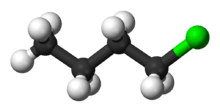1-Chlorobutane
1-Chlorobutane is an alkyl halide with the chemical formula CH3(CH2)3Cl. It is a colorless, flammable liquid.
 | |
| Names | |
|---|---|
| Preferred IUPAC name
1-Chlorobutane | |
| Other names
n-Butyl chloride | |
| Identifiers | |
3D model (JSmol) |
|
| ChEMBL | |
| ChemSpider | |
| DrugBank | |
| ECHA InfoCard | 100.003.361 |
| EC Number |
|
PubChem CID |
|
| RTECS number |
|
| UNII | |
| UN number | 1127 |
CompTox Dashboard (EPA) |
|
| |
| |
| Properties | |
| C4H9Cl | |
| Molar mass | 92.57 g·mol−1 |
| Appearance | Colorless liquid[1] |
| Density | 0.89 g/mL |
| Melting point | −123.1 °C (−189.6 °F; 150.1 K)[1] |
| Boiling point | 78 °C (172 °F; 351 K)[1] |
| 0.5 g/L (20 °C)[1] | |
| Solubility | Miscible with methanol, ether |
| log P | 2.56[2] |
| Vapor pressure | 103.4±0.1 mmHg at 25°C[2] |
| -67.10·10−6 cm3/mol | |
Refractive index (nD) |
1.396[2] |
| Viscosity | 0.4261 mPa·s[3] |
| Hazards | |
| Safety data sheet | Fischer MSDS |
| GHS pictograms |  |
| GHS Signal word | Danger |
GHS hazard statements |
H225 |
| P210, P233, P240, P241, P242, P243, P280, P303+361+353, P370+378, P403+235, P501 | |
| NFPA 704 (fire diamond) | |
| Flash point | 17 °C (63 °F)[1] |
Except where otherwise noted, data are given for materials in their standard state (at 25 °C [77 °F], 100 kPa). | |
| Infobox references | |
Preparation and reactions
It can be prepared from 1-butanol by treatment with hydrogen chloride.[4]
It reacts with lithium metal to give n-butyllithium:[5]
- 2 Li + CH3(CH2)3Cl → CH3(CH2)3Li + LiCl
gollark: * didn't happen
gollark: Idea: what if you make a machine which will automatically open the box if an XK-class scenario occurs/is imminent?]
gollark: Probability fuses or something.
gollark: Although you could have a cool name for it.
gollark: basically the box thing but the same !!!!
References
- Record in the GESTIS Substance Database of the Institute for Occupational Safety and Health
- "1-Chlorobutane CAS#:109-69-3".
- Coursey, B. M.; Heric, E. L. (1971). "AApplication of the Congruence Principle to Viscosities of 1-Chloroalkane Binary Mixtures". Canadian Journal of Chemistry. 49 (16): 2631–2635. doi:10.1139/v71-437. ISSN 0008-4042.
- Copenhaver, J. E.; Whaley, A. M. (1925). "N-Butyl Chloride". Organic Syntheses. 5: 27. doi:10.15227/orgsyn.005.0027.
- Brandsma, L.; Verkraijsse, H. D. (1987). Preparative Polar Organometallic Chemistry I. Berlin: Springer-Verlag. ISBN 3-540-16916-4.
This article is issued from Wikipedia. The text is licensed under Creative Commons - Attribution - Sharealike. Additional terms may apply for the media files.
